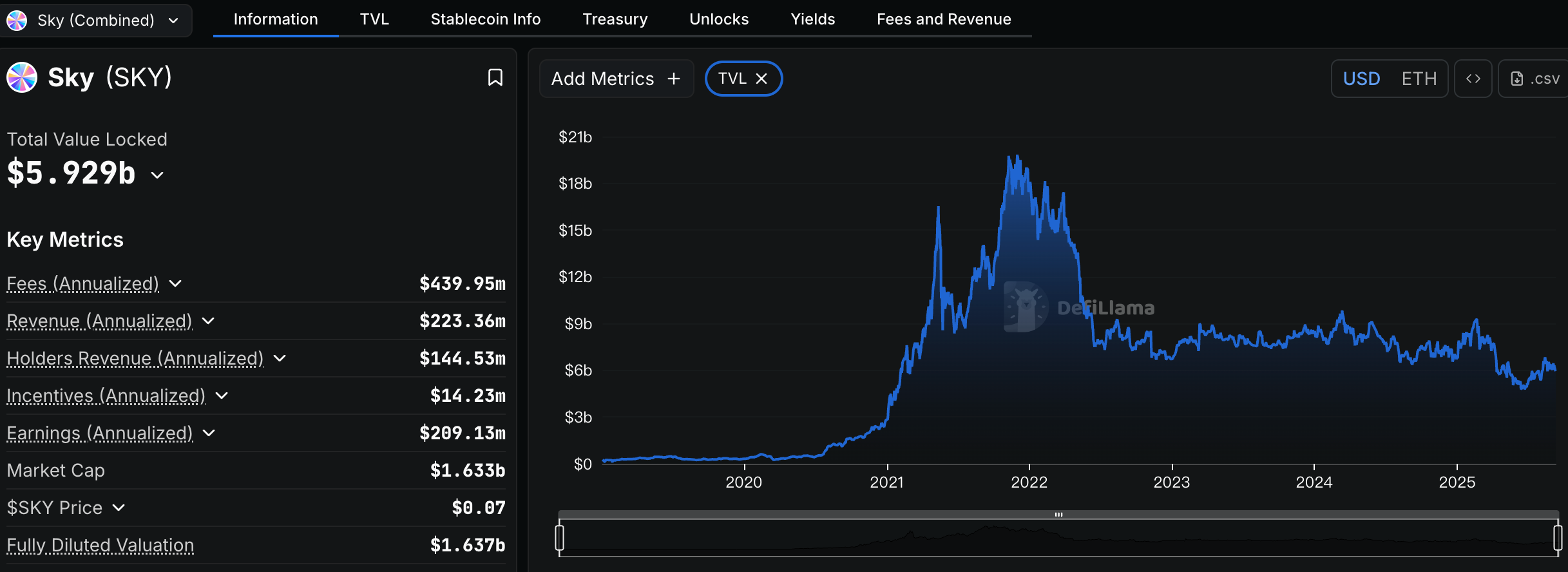Sky (SKY)
represents a significant evolution in the decentralized finance (DeFi) landscape, emerging from the strategic restructuring of
MakerDAO
, one of the oldest and most trusted protocols in the DeFi space. Sky aims to address scalability, user autonomy, and long-term resilience in the rapidly evolving crypto ecosystem as part of the broader Endgame upgrade plan. The protocol's rebranding from MakerDAO to Sky marks more than a name change; it introduces a new dual-token system, enhanced governance mechanisms, and modular sub-ecosystems designed to foster innovation and adoption. This article explores Sky's technology, tokenomics, market performance, and future potential, providing a comprehensive overview of its role in the DeFi sector.
What Is SKY?
Sky is a
decentralized finance protocol that succeeded MakerDAO through a comprehensive rebranding and structural upgrade initiative known as
Endgame. Unlike its predecessor, Sky operates with a dual-token system:
USDS, a collateral-backed stablecoin soft-pegged to the U.S. dollar, and
SKY, a governance and utility token that replaces MakerDAO's MKR token at a fixed conversion rate of 1 MKR = 24,000 SKY. The protocol is accessible via
Sky.money, a non-custodial platform that allows users to engage in various DeFi activities, including minting stablecoins, staking, and participating in governance.
A key innovation in Sky's architecture is the introduction of
modular sub-ecosystems called "Stars," which function like sub-DAOs focused on specific areas such as lending, real-world assets (RWA), and growth initiatives. These Stars operate autonomously while maintaining interoperability with the main protocol, enabling greater scalability and specialization. Additionally, Sky incorporates
SkyLink, a cross-chain bridging mechanism that facilitates the transfer of USDS and SKY tokens across multiple blockchains, including Ethereum, Arbitrum, and Optimism, enhancing liquidity and user accessibility.
The rebranding to Sky also aims to adapt to regulatory changes, simplify brand perception, and expand its user base beyond the traditional crypto community. By building on MakerDAO's legacy while introducing advanced features, Sky positions itself as a next-generation DeFi protocol capable of competing with established stablecoin issuers like Tether.
How Does SKY Work?
Sky operates through a combination of
collateralized vaults,
governance mechanisms, and
incentive systemsdesigned to create a robust and user-friendly DeFi ecosystem. Users begin by depositing accepted collateral, such as ETH or stablecoins like DAI and USDC, into
Sky Vaults. These deposits enable the minting of USDS, Sky's stablecoin, which maintains its peg through over-collateralization and algorithmic adjustments.
The protocol offers several avenues for users to earn yields. The
Sky Savings Rate (SSR) allows USDS holders to earn automatic interest by depositing their tokens into savings accounts, receiving sUSDS in return, which accumulates interest over time. Meanwhile, the
Sky Token Rewards (STR) system distributes SKY tokens to users who actively participate in the ecosystem, such as by minting USDS, providing liquidity, or engaging in governance votes.
Governance in Sky is
decentralized and community-driven. SKY token holders have voting rights on critical decisions, including adjustments to interest rates, collateral types, and system upgrades. This ensures transparency and aligns the protocol's development with the interests of its users.
For cross-chain functionality,
SkyLink enables seamless transfers of USDS and SKY across supported blockchains, reducing transaction costs and improving scalability. This integration allows Sky to leverage the strengths of multiple networks, such as Ethereum's security and Arbitrum's low fees, creating a more versatile and efficient ecosystem.
Finally, the
Stars sub-ecosystems focus on specialized domains like RWA integration and credit markets, fostering innovation within the broader Sky framework. For instance, the Grove Star, allocated $1 billion in funding, collaborates with institutions like Janus Henderson to tokenize institutional-grade collateralized loan obligations (CLOs).
Token Swap
The transition from MakerDAO to Sky involved a systematic
token swap where existing MKR tokens were exchanged for SKY tokens at a fixed ratio of
1 MKR to 24,000 SKY. This process, completed in September 2025, was supported by major cryptocurrency exchanges, including
Bitfinex and SuperEx, which facilitated the swap by closing MKR trading pairs and enabling deposits and withdrawals for SKY.
The token swap was a cornerstone of Sky's
Endgame transformation, aiming to create a more scalable and decentralized governance structure. Holders of MKR had the option to "upgrade" their tokens to SKY voluntarily, with the flexibility to revert to MKR if needed. This approach ensured a smooth transition while maintaining backward compatibility for users who preferred the original tokens.
Following the swap, SKY tokens became the primary governance and utility asset within the ecosystem, while USDS replaced DAI as the flagship stablecoin. The swap also involved updates to smart contracts and governance parameters, reinforcing security and efficiency in the upgraded protocol.
Overview of SKY Tokens
What Is SKY?
SKY TVL. Source: DefiLlama
The SKY token serves as the governance and utility token of the Sky protocol. It replaces MakerDAO's MKR token and plays a central role in decision-making processes, staking, and ecosystem incentives. With a maximum supply capped at 1 billion tokens, SKY is designed to be deflationary over time, as tokens are burned through ecosystem activities like governance proposals and transaction fees.
Applications of SKY
SKY tokens are used for multiple purposes within the Sky ecosystem. Primarily, they enable governance participation, allowing holders to vote on proposals related to protocol upgrades, collateral types, and risk parameters.Additionally, SKY tokens are used for staking, where users lock their tokens to earn rewards from the Sky Token Rewards (STR) system. They also facilitate payment for transaction fees and access to premium features on the Sky.money platform.
Price Prediction and Market Analysis
Market Performance
SKY has exhibited
significant volatility since its launch, with prices ranging from approximately
$0.036 to $0.10. As of Q3 2025, the token trades around $0.10, with a market capitalization exceeding $170 million, positioning it as a mid-sized cryptocurrency. Trading volumes have fluctuated, often reflecting broader market trends and ecosystem developments.
Price Prediction
Price predictions for SKY vary based on adoption rates, technological advancements, and market conditions.
Conservative estimates suggest prices could reach
$0.09 by 2026, while
more optimistic scenariosproject values of
$0.18 if the protocol achieves widespread adoption and partnerships. By 2028, predictions range from
$0.13 in a stable market to
$0.35 if Sky successfully expands into real-world assets and institutional finance.
Technical indicators, such as the
Relative Strength Index (RSI) and
Moving Average Convergence Divergence (MACD), often signal potential price movements. For instance, an RSI below 30 may indicate oversold conditions, potentially leading to short-term rebounds. However, these predictions are speculative and should be approached with caution, given the inherent volatility of cryptocurrency markets.
Latest News
Sky has actively expanded its ecosystem through strategic partnerships and initiatives. In September 2025, Sky entered the competition to issue
Hyperliquid's USDH stablecoin, proposing to offer a
4.85% annual yield to holders and committing $25 million to develop a Hyperliquid-native ecosystem project. This move aims to leverage Sky's experience in stablecoin management and its $8 billion balance sheet to enhance USDH's liquidity and adoption.
The protocol has also partnered with
institutional players like BlackRock to explore tokenized asset offerings, further bridging traditional finance and DeFi. Additionally, Sky's integration with
Trust Wallet has enabled millions of users to access its features, simplifying interactions with the protocol.
Despite these advancements, Sky faces challenges, including regulatory scrutiny and competition from other stablecoin projects like Frax and Paxos. However, its focus on compliance, exemplified by efforts to align with the
GENIUS Act, positions it favorably for future growth.
Conclusion
Sky (SKY) represents a transformative step in the evolution of decentralized finance, building on MakerDAO's legacy while introducing innovative features like modular sub-ecosystems and cross-chain functionality. Its dual-token system, combining the USDS stablecoin and SKY governance token, creates a robust framework for user engagement and ecosystem growth.
While Sky shows promise through strategic partnerships and a clear vision for DeFi expansion, it operates in a highly competitive and volatile market. Price predictions and market performance indicate growth potential, but success hinges on widespread adoption, regulatory compliance, and continuous innovation.
For investors and users, Sky offers a compelling opportunity to participate in the future of DeFi, though it requires careful consideration of risks and market dynamics. As the protocol continues to evolve, its ability to integrate real-world assets and expand its stablecoin offerings will be critical to its long-term success.
Reference:
CoinCatch Team
Disclaimer:
Digital asset prices carry high market risk and price volatility. You should carefully consider your investment experience, financial situation, investment objectives, and risk tolerance. CoinCatch is not responsible for any losses that may occur. This article should not be considered financial advice.



